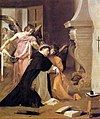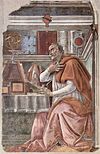Desconstrução e religião
| História da teologia |
| Teologia cristã |
|---|
 |
|
Visões teológicas da história |
|
Desenvolvimento Pós-Niceno |
|
Reforma
|
O termo desconstrução-e-religião descreve um modo não teísta de pensamento que procede de uma teologia e de um quadro desconstrutivo. Em termos de teologia dogmática, desconstrução-e-religião varia do certamente ateu até o quase ateu.
Aqueles que têm uma abordagem desconstrutiva da religião se identificam de perto com o trabalho de Jacques Derrida, especialmente o seu trabalho mais posterior. De acordo com Slavoj Zizek, em meados da década de 80, a obra de Derrida mudou de constituir uma teologia negativa radical para ser uma forma de idealismo Kantiano.[1] John D. Caputo descreve o trabalho de Derrida na década 70 como um nietzscheano livre jogo de significantes, enquanto ele descreve o trabalho de Derrida na década de 90 como uma "religião sem religião."[2]
Indesconstrutibilidade
[editar | editar código-fonte]
Uma característica fundamental do trabalho de Derrida é a noção de Indesconstrutibilidade. No pensamento de Derrida, a desconstrução existe no intervalo entre as construções e indesconstrutibilidades. O primeiro exemplar dessa relação é a relação entre a lei, a desconstrução e a justiça. Derrida resume a relação, dizendo que justiça é a condição indesconstrutível que torna a desconstrução possível.[3] No entanto, a justiça referida por Derrida é indeterminada e não um ideal transcendente.
A lei é feita de construções humanas necessárias, enquanto a justiça é o chamado indesconstrutível de fazer leis. A lei pertence ao reino do presente, do possível, e do calculável, enquanto que a justiça pertence ao reino do ausente, do impossível, e do incalculável. A desconstrução cria pontes entre o fosso da lei e da justiça, como a experiência da aplicação da lei de forma justa. A justiça exige que uma ocorrência singular seja respondida com uma novidade, unicamente costurada da lei. Assim, uma leitura desconstrutiva da lei é um salto do calculável para o incalculável.
Na desconstrução, a justiça assume a estrutura de uma promessa ausente, e impossibilidade que pode ser feita presente e possível. Na medida em que a desconstrução é motivada por essa promessa, ela escapa do binário tradicional presença/ausência porque a promessa não é nem presente nem ausente. Portanto, uma leitura desconstrutiva nunca definitivamente alcança a justiça. A justiça é sempre adiada.
Escritores
[editar | editar código-fonte]
|
|
Referências
[editar | editar código-fonte]Referências primárias
[editar | editar código-fonte]- (1992) The Ethics of Deconstruction: Derrida and Levinas, by Simon Critchley
- (1993) Against Ethics - Contributions to a Poetics of Obligation with Constant Reference to Deconstruction, by John D. Caputo
- (1995) On the Name, by Jacques Derrida
- (1996) The Gift of Death, by Jacques Derrida
- (1997) The Prayers and Tears of Jacques Derrida, by John D. Caputo
- (1998) Religion, with Jacques Derrida & Gianni Vattimo
- (2001) Acts of Religion, by Jacques Derrida
- (2005) The Future of Religion, with Richard Rorty, Gianni Vattimo, & ed. by Santiago Zabala *[1]
- (2007) Dis-Enclosure: The Deconstruction of Christianity, by Jean-Luc Nancy
Referências secundárias
[editar | editar código-fonte]- (1982) Deconstructing Theology, by Mark C. Taylor
- (1987) Erring: A Postmodern A/theology, by Mark C. Taylor
- (1993) Theology of Discontent: The Ideological Foundations of the Islamic Revolution in Iran, by Hamid Dabashi
- (1995) Desiring Theology, by Charles Winquist
- (1997) Deconstruction in a Nutshell: A Conversation with Jacques Derrida, ed./auth. by John D. Caputo
- (1999) About Religion: Economies of Faith in Virtual Culture, by Mark C. Taylor
- (1999) Epiphanies of Darkness: Deconstruction in Theology, by Charles Winquist
- (1999) Ethics-Politics-Subjectivity: Essays on Derrida, Levinas, and Contemporary French Thought, by Simon Critchley
- (1999) Truth and Narrative: The Untimely Thoughts of Ayn al-Qudat al-Hamadhani, Hamid Dabashi
- (2000) "In the Absence of the Face," by Hamid Dabashi. In Social Research, Volume 67, Number 1. Spring 2000. pp. 127-185.
- (2001) "Derrida and Technology: Fidelity at the Limits of Deconstruction and the Prosthesis of Faith," by Bernard Stiegler. In Tom Cohen (ed.), Jacques Derrida and the Humanities
- (2001) On Religion, by John D. Caputo
- (2004) Portrait of Jacques Derrida as a Young Jewish Saint, by Hélène Cixous
- (2004) Sufism and Deconstruction, by Ian Almond
- (2006) Philosophy and Theology, by John D. Caputo
- (2006) The Weakness of God: A Theology of the Event, by John D. Caputo
- (2007) After God by Mark C. Taylor
- (2007) After the Death of God, with John D. Caputo, Gianni Vattimo, & ed. by Jeffrey W. Robbins
- (2008) Radical Atheism: Derrida and the Time of Life, by Martin Hägglund
Ver também
[editar | editar código-fonte]- Filosofia continental
- Desconstrução
- Différance
- List of deconstructionists
- Metaphysics of presence
- Ontotheology
Notas e referências
- ↑ (2006) Žižek, Slavoj, "A Plea for a Return to Differance (with a minor 'Pro Domo Sua')" Critical Inquiry 32 (2): 226-249
- ↑ (2002) Raschke, Carl, "Loosening Philosophy’s Tongue: A Conversation with Jack Caputo" http://www.jcrt.org/archives/03.2/caputo_raschke.shtml
- ↑ (2001) Derrida, Jacques, Acts of Religion, p. 243.
Ligações externas
[editar | editar código-fonte]Leituras on-line
[editar | editar código-fonte]- "Jacques Derrida (1930 - 2004)"(pdf), by John D. Caputo
- "Religion and Violence: Plea for a 'Weak' Theology in Tempore Belli"(pdf), by Ulrich Engel OP
- "The Weakness of God: A Review of John D. Caputo's 'The Weakness of God: A Theology of the Event'"(pdf), by Peter G. Heltzel
- "Already, Not Yet: A Review of Jean-Luc Nancy's 'La Déclosion : Déconstruction du christianisme, 1'"(pdf), by Adam Kotsko
- "Weak Theology"(pdf), by Jeffrey W. Robbins
- "Take Care", by Bernard Stiegler
Sites acadêmicos
[editar | editar código-fonte]- Homepage of John D. Caputo, Thomas J. Watson Professor of Religion and Humanities at Syracuse University
- Homepage of Simon Critchley, Professor of Philosophy at the New School for Social Research
- Homepage of Jeffrey W. Robbins, Assistant Professor of Religion and Philosophy at Lebanon Valley College
- Homepage of Richard Rorty, Professor Emeritus of Comparative Literature at Stanford University
- Homepage of Mark C. Taylor, Cluett Professor of Humanities at Williams College
- Homepage of Gianni Vattimo, Professor of Theoretical Philosophy at the University of Turin
- Homepage of Santiago Zabala, Alexander von Humboldt Research Fellow at Potsdam University Institute of Philosophy
Text is available under the CC BY-SA 4.0 license; additional terms may apply.
Images, videos and audio are available under their respective licenses.





